Reading: Momosuke Fukuzawa (Tosuke)
Other notation: Momosuke Fukuzawa
Former name: Momosuke Iwasaki
Momosuke Fukuzawa was a businessman active from the late Meiji period to the early Showa period. He was mainly active in the Japanese electric power industry and was nicknamed the "Electric Power King of Japan. Momosuke Fukuzawa, maiden name Momosuke Iwasaki, was born on June 25, Keio 4, 1868 (new calendar: August 13, 1868) in Arako-mura, Yokomi-gun, Musashi Province, present-day Yoshimi-machi, Hiki-gun, Saitama Prefecture, and spent his childhood in present-day Kawagoe City, where he was from a poor family. He excelled in academics to the extent that he is said to have been a prodigy.
At the age of 16, he moved to Tokyo and entered Keio Gijuku, a private school founded by Yukichi Fukuzawa. Momosuke, who was somewhat good at sports, caught the attention of the Fukuzawa family at an athletic meet during his school days and was chosen as a candidate for Yukichi's second wife's marriage. At this athletic meet, he wore a white shirt with a large lion on the front, and he seemed to be a young man who liked to stand out.
Also around this time, Sadayakko (the first actress in Japan, later Sadayakko Kawakami), then 14 years old, was riding a horse and was attacked by a wild dog while riding. Momosuke chased away the wild dog and saved her. This is said to be the first encounter between Momosuke and Sadayakko. Sadayakko later married Kawakami Otojiro, a performer of the "opekepee-busi" style, and after Otojiro's death, some sources say that the two had a mistress relationship, but in reality they were business partners.
On December 17, 1886, he became Momosuke Fukuzawa's adopted son-in-law on the premise that the Fukuzawa family would provide for his study abroad expenses after graduation and that he would marry Fusa. Three years later, in 1889, he returned from his study in the U.S. and married Fusa in December.
Background.the following tableThe results were summarized in the following table.
He died at his main residence in Shibuya, Tokyo on February 15, 1938. He was 69 years old.
- Momosuke Fukuzawa's Brilliant Work Experience
- Momosuke Fukuzawa's sanctuary
- birthplace
- Momosuke Fukuzawa Birthplace Monument
- Statue of Dr. Momosuke Fukuzawa Hisashi near Shimomura Weir
- Statue of Dr. Momosuke Fukuzawa Kotobuki at the Nanxiang Power Station
- Statue of Momosuke Fukuzawa, King of Electric Power in Ena Gorge Sazanami Park
- Momosuke Fukuzawa Memorial Hall
- bridge designed to be underwater during a flood
- Kaki其水路橋
- Bunka no Michi Futabakan Former Sadayakko Kawakami Residence, Nagoya
- Joushouji Temple
- Monument in remembrance of Momosuke Fukuzawa at Nittaiji Temple's Shariden (monument for Momosuke Fukuzawa sensei)
- Tomb of Momosuke Fukuzawa
- Pilgrimage Map of the Holy Land
- Books and DVDs related to Momosuke Fukuzawa
- reference data
Momosuke Fukuzawa's Brilliant Work Experience
| December 1889 | Hokkaido Coal Mine Railway (later Hokkaido Coal Mine Steamship Company), Joined |
| April 1893 | Discharged from Hokkaido Coal Mine Railway |
| June of the same year | Returned to work for Hokkaido Coal Mine Railway as an executive employee. |
| Summer, 1894 | Suffering from tuberculosis, he took the opportunity to invest in stocks and amassed a large fortune. |
| October 1895 | Retired from Hokkaido Coal Mine Railway |
| September 1898 | Appointed as Director of Oji Paper |
| 1899 (Meiji 32nd year) | Marusan Shoten (Marusan Shokai) is established. |
| 1900 (Meiji 33rd year) | Resigned as Director of Oji Paper |
| July 1901 | Returned to Hokkaido Coal Mine Railway as Executive Manager |
| 1906 (Meiji 39) | Receives farm from Motoi Horiki, President of Hokkaido Coal Mine Railway (Fukuzawa Farm) |
| October of the same year | Resigned from Hokkaido Coal Mine Railway |
| the same age | Established Teikoku Fertilizer and became a director. |
| the same age | Acquires Marusan Beer, Kabuto Beer, renamed Japan Daiichi Beer, and becomes director |
| January 1907 | Resigned from Nippon Daiichi Beer Established Seto Mine Co., Ltd. and assumed the position of Senior Managing Director Established Nisshinbo Co., Ltd. and became the first Senior Managing Director |
| February of the same year | Appointed as Auditor of Tokyo Fukuro Orimono |
| July 1908 | Appointed as Director of Toyohashi Electric Co. |
| October of the same year | Hirotaki Hydroelectric Company, the company's major shareholder, opens for business. |
| 1909 (Meiji 42nd year) | Appointed president of Toyohashi Electric |
| January of the same year | Appointed from Auditor to Director of Tokyo Fukuro Orimono |
| July of the same year | Appointed as Director of Tobu Bank (formerly Katsushika Bank) Appointed as an advisor to Nagoya Electric Light Co. |
| August of the same year | Tokyo Fukuro Orimono is renamed Tokyo Seifun. Established Fukuhaku Electric Railway Co., Ltd. and assumed the position of president. |
| October of the same year | Appointed Advisor to Nagoya Electric Light Co. |
| January 1910 | Appointed Director of Nagoya Electric Light Co. |
| April of the same year | Resigned as Senior Managing Director of Nisshinbo Established NIPPON GAS CO. |
| May of the same year | Appointed Managing Director of Nagoya Electric Light Co. Shimonoseki Gas is established and he becomes the first president. Kumamoto Gas is established and he becomes a director. |
| July of the same year | Niigata Gas and Kagoshima Gas are established and he becomes the first president. |
| September of the same year | Himeji Gas is established and he becomes a director. Established Kyushu Electric Co., Ltd. and assumed the position of Director |
| October of the same year | Omuta Gas is established and he becomes the first president. |
| November of the same year | Transferred to Director of Nagoya Electric Light Co. |
| March 1911 | Appointed president of Shikoku Hydroelectric (formerly Sanuki Electric) Appointed as Director of Matsuyama Electric Railway |
| April of the same year | Wakayama Gas is established and he becomes the first president. |
| May of the same year | Hamada Denki is established and becomes President and Director |
| June of the same year | Tokyo Seifun dissolved. Established Noda Electric Co. |
| July of the same year | Resigned as Director of Tobu Bank |
| October of the same year | Established Karatsu Orbital and assumed the position of Director |
| November of the same year | Hakata Electric Light and Fukuhaku Electric Railway merge to form Hakata Electric Light Railway; assumes post of Advisor |
| 1912 (the 45th year of Meiji era) | Transferred to Senior Managing Director of Toyohashi Electric |
| June of the same year | Kyushu Electric (formerly Hirotaki Hydroelectric) and Hakata Electric Railway merge to form Kyushu Electric Railway Co. Appointed as Senior Advisor. Kure Gas is established and he becomes a director. |
| October of the same year | Establishes Sasebo Electric Co., Ltd. and assumes the position of president Imabari Gas is established and he becomes a director. |
| January 1913 | Reappointed Managing Director of Nagoya Electric Light Co. |
| May of the same year | He ran in the 11th general election for the House of Representatives from the county constituency of Chiba Prefecture and was elected as the top candidate. Served until December 1914. |
| June of the same year | Niigata Gas and Chiba Gas are merged to form Godo Gas (now Hokuriku Gas), of which he becomes president. |
| August of the same year | Seibu Godo Gas (now Seibu Gas) established by integrating 10 gas companies in Kyushu and Yamaguchi prefectures; appointed president |
| December of the same year | Matsuyama Electric Railway resigns as director. |
| December 1914 | Promoted to President of Nagoya Electric Light Co. Assumed the position of President of Seibu Godo Gas and was transferred to the position of Senior Advisor |
| August of the same year | Appointed president of Aichi Electric Railway (now Nagoya Railroad Co., Ltd.) |
| 1915 (Taisho 4) | Sale of Seto Mine |
| June 1916 | Noda Electric dissolved |
| August of the same year | Retired from Hamada Electric Established Denki Steel Works Co., Ltd. and assumed the position of Advisor |
| June 1917 | Shikoku Hydroelectric resigns Retired from Aichi Electric Railway |
| September of the same year | Appointed president of Denki Steel Works |
| 1918 (Taisho 7) | Reappointed president of Toyohashi Electric Co. |
| April of the same year | Established Tokai Electrode Manufacturing Co. |
| September of the same year | Established Kiso Electric Steel Co., Ltd. and assumed the position of president. |
| March 1919 | Established Yahagi Hydro Co., Ltd. and assumed the position of Advisor |
| June of the same year | Established Hakusan Hydro Co., Ltd. and assumed the position of Advisor |
| September of the same year | Nagoya Cement Co., Ltd. is established and he becomes a director. Tokaido Electric Railway established and appointed president |
| November of the same year | Osaka Soden Co., Ltd. established and appointed president. |
| February 1921 | Kisogawa Electric Power Company, Osaka Transmission & Distribution, and Japan Hydro merge to form Daido Denryoku Co. |
| March of the same year | Establishes Nobi Electric Co., Ltd. and assumes the position of Advisor |
| July of the same year | Established Ozan Denryoku Co., Ltd. and assumed the position of Advisor |
| October of the same year | Nagoya Electric and Kansai Hydroelectric merge to form Kansai Electric Co. |
| December of the same year | Resigned as President of Kansai Electric, merged with Kyushu Electric Railway, and transferred to the position of Advisor |
| August 1922 | Nagoya Cement and Saga Cement merged into Toyokuni Cement, and Toyokuni Cement appointed president. |
| 1925 (Taisho 14) | Resigned from Niigata Gas |
| 1926 (Taisho 15) | Appointed Chairman of the Imperial Theatre Co. |
| March 1928 | Ceded the post of Chairman of the Imperial Theatre and became Honorary Advisor |
| June of the same year | Resignation of Daido Denryoku President |
| September of the same year | Awarded the Order of the Rising Sun, Gold Rays with Neck Ribbon |
| November of the same year | Toyokuni Cement resigns as president of Kisogawa Electric Power Co. |
| December of the same year | Resigned as Director of Shikoku Hydroelectric |
| November 1930 | Toyokuni Cement President reappointed. |
| 1932 (the 7th year of the Showa era) | Resignation of Toyokuni Cement President |
Momosuke Fukuzawa's sanctuary
We have compiled a list of places associated with Momosuke Fukuzawa to serve as a reference for pilgrims to the Holy Land. The list is too detailed to mention all the places, so we have only selected the most representative ones.
birthplace
In Yoshimi Town, Saitama Prefecture, where his birthplace was located, there is a signboard indicating his birthplace along Prefectural Route 33. In this village, there are many people with the surname Iwasaki, Momosuke's maiden name. (See the following table).Google Maps)
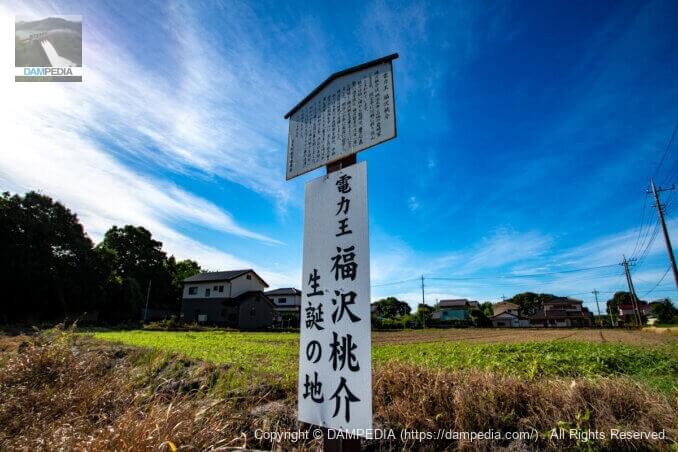
Momosuke Fukuzawa Birthplace Monument
The actual birthplace seems to have been located further back from the prefectural road, and a small stone monument has been erected. The name "Iwasaki" is engraved on an adjacent gravestone, but it is unclear if it belongs to the family. (The name of the family is not known.Google Maps)
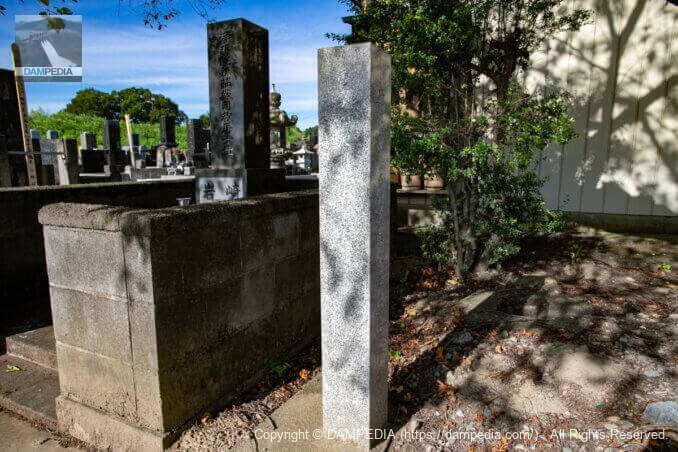
Statue of Dr. Momosuke Fukuzawa Hisashi near Shimomura Weir
Five of the eight statues were offered for sale during the Pacific War, and three remained at the Uemura Power Station of Chubu Electric Power Company, the Soyama Power Station of Kansai Electric Power Company, and the Yoshinotani Power Station of Hokuriku Electric Power Company. On the occasion of the 100th anniversary of Momosuke Fukuzawa's birth in June 1968, the sculptures were moved to the Chubu Electric Power Human Resources Development Center. The remaining one was donated to Shikoku Electric Power Company. Later, in December 1996, the one that had been installed at the Kamimura Power Station was relocated near the Shimomura weir (on the premises of the Kamiyasaku Promotion Office) as a project commemorating the 45th anniversary of the founding of Chubu Electric Power Company. (Google Maps)
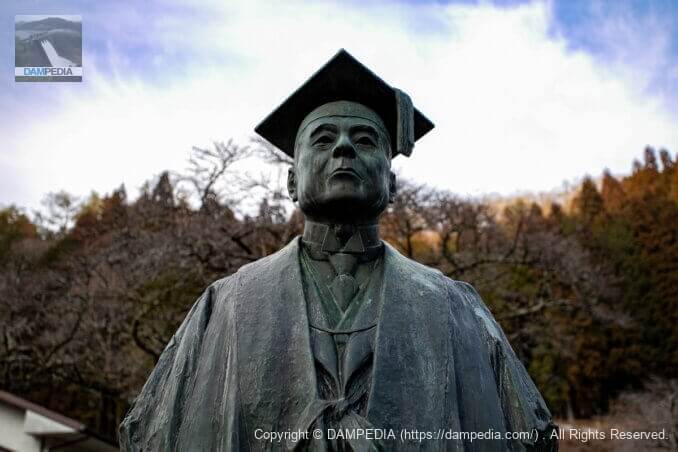
Statue of Dr. Momosuke Fukuzawa Kotobuki at the Nanxiang Power Station
One of eight statues created by the aforementioned sculptor Nitta Totaro. (Google Maps)
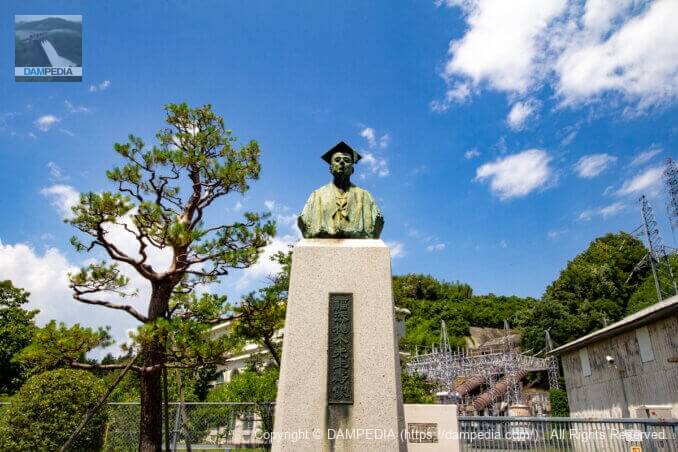
Statue of Momosuke Fukuzawa, King of Electric Power in Ena Gorge Sazanami Park
It is installed on a hill in Enakyo Sazanami Park overlooking the upstream face of the Oi Dam, together with a relief of Sadayakko Kawakami. The image of Momosuke staring firmly at the Oi Dam is very impressive. (See the photo below.)Google Maps)
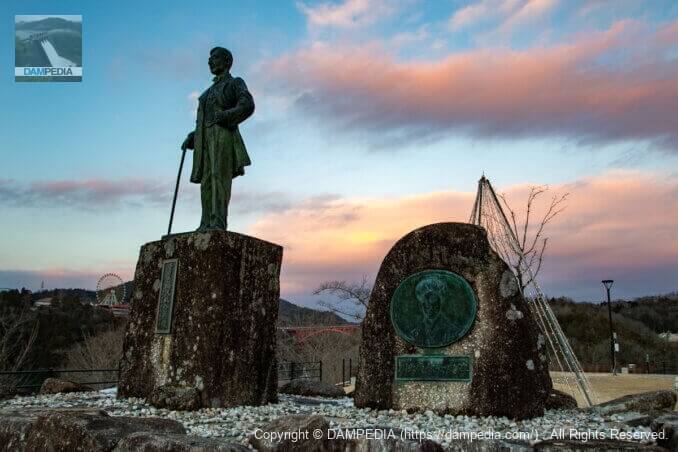
Momosuke Fukuzawa Memorial Hall
Momosuke's villa, built in 1919 to direct the construction of the power plant, is open to the public as a memorial museum. The fee is 500 yen for adults (with the adjacent Mountain History Museum). The museum is open from 9:30 to 16:30, but is closed in winter (December 1 to mid-March) and on Wednesdays. (The museum is open from 9:30 a.m. to 4:30 p.m.Google Maps)

bridge designed to be underwater during a flood
The suspension bridge was built over the Kiso River in 1922, but it was originally built to transport construction materials for the Yomisho Power Plant, and some traces of trolley rails were laid in the center of the bridge. In 1950, the bridge was donated to the then village of Yomisho and became a village road, but in 1978, it was in danger of being closed due to its age. It was restored in 1993 as a hometown creation project. The bridge has been designated as a national important cultural property as part of the Yomisho Power Plant facilities, and is also recognized as a Heritage of Modernization. (Google Maps)
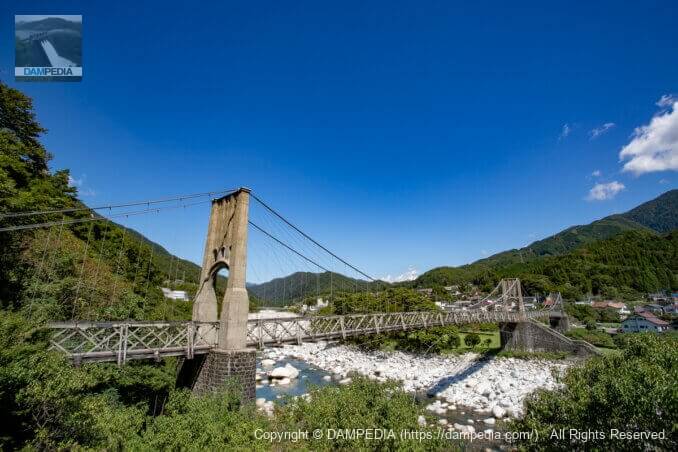
Normally, bridges are built to shorten the distance between rivers in order to reduce costs and construction work, but the Momosuke Bridge was built on a wide river not perpendicular to the direction of the river, but at an angle to it.
One reason for this is to compensate for the difference in elevation in transporting materials to Minami-Kiso Station, but I personally find Momosuke's episode more interesting because the electric power company at that time was truly a venture business, and was proud of its spirit and technological prowess.
Kaki其水路橋
A double-arch reinforced concrete bridge that crosses the Kakinoki-gawa River as part of the water conduit to the Yomisho Power Station. Together with Yomisho Power Station and Momosuke Bridge, it is a National Important Cultural Property and a Heritage of Modernization. (The bridge is located on the south side of the Yomiuri River.Google Maps)
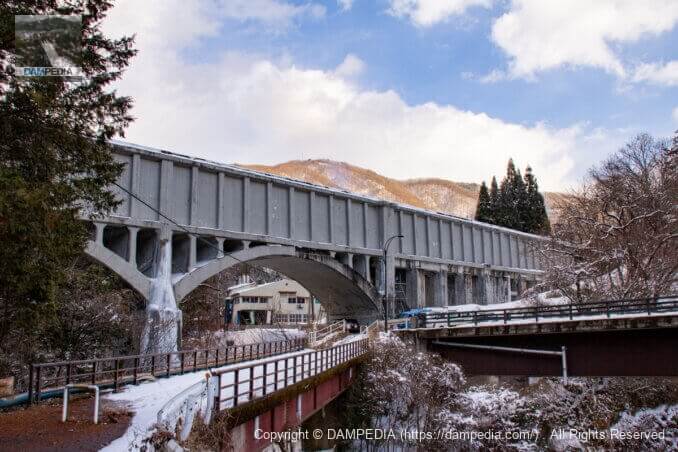
Bunka no Michi Futabakan Former Sadayakko Kawakami Residence, Nagoya
The building where Sadayakko Kawakami, also known as the first Japanese actress, and her business partner Momosuke Fukuzawa lived together. It was built around 1920 at 18 Higashi Futaba-cho, Higashi Ward, Nagoya City (near the current 3-chome Shirakabe, Higashi Ward. The building was originally built around 1920 in Higashi Futaba-cho 18, Higashi Ward, Nagoya City (near present-day Shirakabe 3-chome, Higashi Ward, one of Nagoya's most prestigious residential areas), but was moved and restored to its current location at 23, Yugi-cho 3-chome, Higashi Ward. The museum also exhibits a bag and other items used by Momosuke. Admission is 200 yen for adults. The museum is open from 10:00 to 17:00, closed on Mondays (or the following day if Monday is a national holiday) and December 29 to January 3. Admission is 200 yen for adults and 200 yen for children.Google Maps)

Joushouji Temple
This temple was built in 1933 by Sadayakko Kawakami with his private funds. When it was first built, it was called Kongosan Momokoin Teishoji Temple, and the name of the temple was derived from Momosuke. Around the main hall are carved wooden reliefs that religiously represent Sadayakko's life. The relief of the Oi Dam in particular is a must-see. The tablets of Momosuke as well as Sadayakko are enshrined in the main hall. To the north of the main hall is Sadayakko's mausoleum, with a statue of the Goddess of Mercy standing in front of it, said to be looking in the direction of the Oi Dam. (See alsoGoogle Maps)
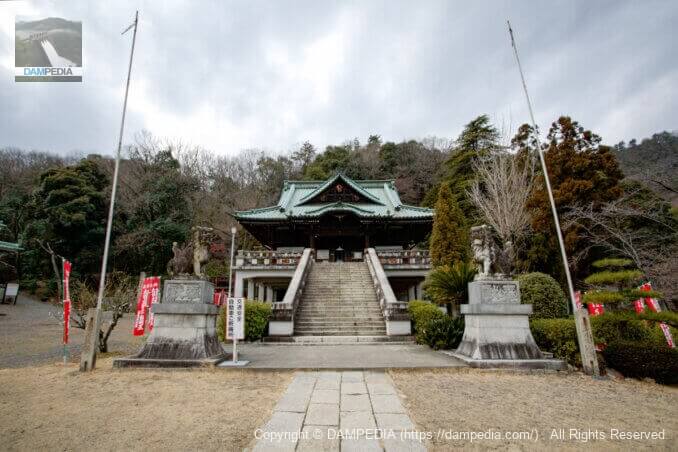
On the other side of the national highway is Manshoen, the former villa of Sadayakko Kawakami. The former Sadayakko Kawakami villa is usually closed to the public because it is used as a wedding hall by a general corporation, but tours are held twice a month. It is designated as a National Important Cultural Property.
Monument in remembrance of Momosuke Fukuzawa at Nittaiji Temple's Shariden (monument for Momosuke Fukuzawa sensei)
The "Monument in Memory of Momosuke Fukuzawa (Monument to Mr. Momosuke Fukuzawa)" stands on the east side of the entrance to the Nittaiji Shariden Hall in Chikusa-ku, Nagoya City. The monument is dedicated to Momosuke's life and his contributions to the development of the Chubu economy. (Japanese only)Google Maps)
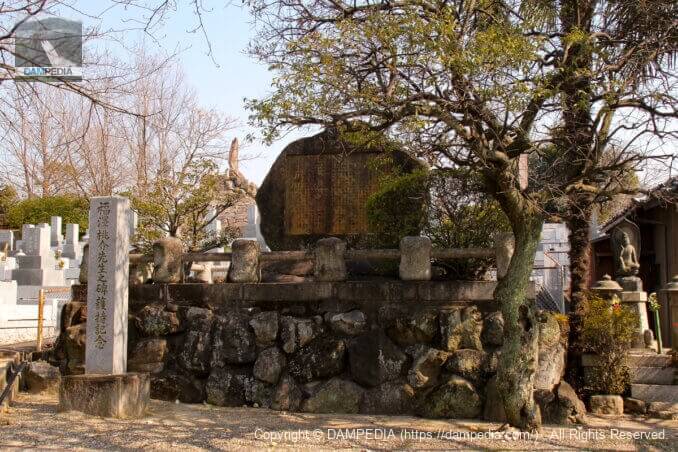
Mr. Momosuke Fukuzawa was a genius of the highest order, and his contribution to the national society was so vast that it deserves a special mention in the economic history of the Meiji and Taisho eras. He was born in Saitama Prefecture and studied at Keio University. Mr. Fukuzawa's interest in Central Japan began in 1909 when he became involved with the Nagoya Electric Light Company, which at that time was mainly engaged in the supply of lights and mainly relied on thermal power. In order to transmit the increased power in this way, large transmission lines were constructed and several electric power companies were added to the system. The river water, which ran silently and blindly through the valleys of the Owari-Shinano for ten million years, became electric heat and light, bringing light and warmth to millions of homes and houses, becoming electric power and triggering thousands of industries large and small. As the spring water filled the four streams, Nagoya's population increased, making it the third largest city in Japan. Decades ago, someone did not know that the valley water of Nobuo contained such great power, but only Mr. Fukuzawa's keen sense of perception and his ability to make full use of this mute, blind running water to open up the civilization of electric power in Central Japan. In order to commemorate Mr. Fukuzawa, his old friends have joined forces to erect a monument, and I have written a record of his achievements in the Nagoya area.
Monument in Remembrance of Momosuke Fukuzawa (Monument to Momosuke Fukuzawa Sensei)
November 1933
Privy Counselor, Written by Takekoshi Yozaburo, Privy Counselor, Nomoto Hakuun
Tomb of Momosuke Fukuzawa
The burial site will be Ward 9, Type 1, Side 7, Number 1 of the Tama Cemetery. (Google Maps)
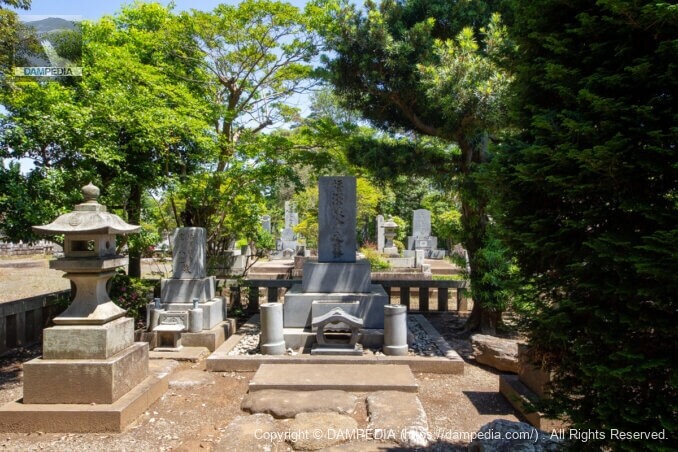
Pilgrimage Map of the Holy Land
Books and DVDs related to Momosuke Fukuzawa
Momosuke Fukuzawa Shiki" is a revised and modernized version of "Momosuke Shiki" published by Jitsugyo no Sekai-sha in 1911. It is sprinkled with Momosuke's life lessons and wise sayings.
Water Burns Fire is a novel based on a true story. Personally, I would like to see this developed into an epic drama or morning drama based on this story.
DVD
rare book
Meiji Toikou Kougyou (Meikoi)
A media mix work by Dwango. The work is primarily an adventure game for women in which celebrities from the Meiji era appear as handsome men. This work includes the appearance of Momosuke Iwasaki (called Tousuke instead of Momosuke in the work), whose maiden name is Momosuke Iwasaki after Full Moon released on August 25, 2016. He appears in the film as Shota Matsushima (anime CV: Yoshimasa Hosoya, live-action film actor: Shota Matsushima). Abbreviated name "Meikoi".
reference data
Chubu Branch of the Japan Electric Association "People who built Chubu Energy".

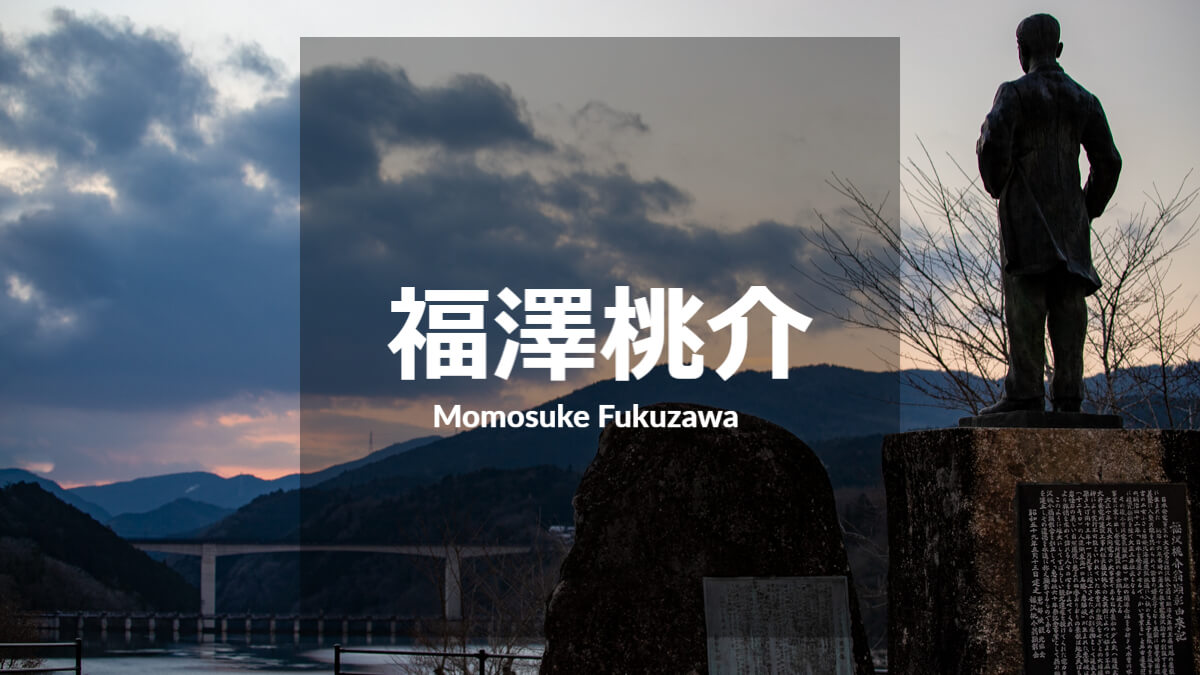


Comment